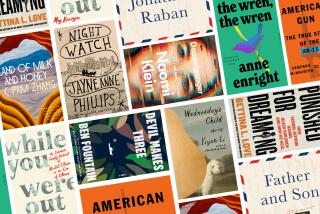The World Goes Mad : After 39 Years, the Zany Magazine Gets Serious Treatment in a Big, Glossy Coffee-Table Book--Just the Kind of Thing It Mocks
- Share via
Black spy, white spy and sometimes the gray lady spy blow each other up without exchanging a word. They’ve been doing it since 1961 in Antonio Prohias’s “Spy vs. Spy.”
Movie-star caricatures trade puns in squared-off, interlocking speech balloons. Across the margins stretch itsy-bitsy disaster comics.
For 39 years, Mad magazine has sketched out and read between the lines of American idiocy, targeting everything from lawn care to the evening news.
One object of Mad’s satire was big, expensive, glossy gift books: “You’re supposed to buy one as a gift to impress a friend, who will then put it on his coffee table, to impress his friends.”
This wisdom has now been preserved for posterity--in Mad’s own big, expensive, glossy gift book, “Completely Mad,” published this month by Little, Brown & Co.
Maria Reidelbach, the author, wasn’t trying for irony. She says of including Mad’s sendup of books like hers in her book, “I have no rationalization. There’s no excuse. I should be shot.”
The publisher is happy with the book’s format. The first printing of 30,000 sold out a week before publication. Bootleg copies were available on New York street corners. Mad’s spiritual descendant, Spy magazine, is throwing a celebratory bash at the New York branch of Ed Debevic’s tonight.
William M. Gaines, Mad’s publisher, co-creator, and resident father figure, is also delighted, and why not?
“Completely Mad” is a lush and straight-faced history of his life’s work, going back to his father Max’s role in inventing the comic book; through the full-color Mad magazines Harvey Kurtzman edited in the mid-’50s; to the current black and white format that still sells some 800,000 copies eight times a year, these days as a product of Time Warner.
Reidelbach describes Mad in every detail. She catalogues its targets. She analyzes its wordplay (although she never nails down Rpotrzebie --reportedly a brand of Polish aspirin). She walks readers through Mad’s overstuffed, toy-strewn Manhattan offices where the decor includes a year-round Christmas tree, zeppelin models, a drum set and--in a surprising show of gravity--back issues of Mad bound in leather.
She reports every stage of Mad’s physical production, from rough idea to press run, marveling over steps as common as proofreading. She mentions every writer, artist, secretary and accountant. She even devotes 15 pages to the history of Mad’s gap-toothed mascot. (The “What, Me Worry?” face had been a staple in ads and joke postcards since 1895. Mad appropriated the image and named him Alfred E. Neuman.)
Mad fans longing for a durable collection of favorite parodies, full-size covers or fold-ins past had better look elsewhere. “Completely Mad” is completely serious. Reidelbach has curated exhibits of political cartoons and Victorian underwear, catalogued paintings of the ‘80s superstar Eric Fischl and co-authored a history of miniature golf. She plumbs for the meaning of Mad.
Sprinkling her text with terms such as polyethnic, prescient and postmodern eclecticism, she finds Mad to be a seminal journal of cultural critique--the root of all spoofing during the 1950s, ‘60s and ‘70s.
“Mad magazine tended to be a surprisingly important influence on people at a certain point in their growing up,” she explains. “I wanted to look at that, and look at the role that Mad played in society, and the interplay between Mad and society, and use Mad as a window to look at changes in the United States.
“I wanted it to be the kind of book you can pick up and put down and go back to over and over again,” Reidelbach says. “It’s not quite a coffee-table book. It’s sort of like an end-table book, or a rest-it-on-the-back-of-your-toilet book.”
Reidelbach first proposed her project to William Gaines in March, 1988. She walked out of that meeting with a handwritten note promising Mad’s cooperation. Gaines would open Mad’s archives for her research. He would also have final approval of the book.
She turned to Alexander Isley, trend-setting art director of the early Spy, to give “Completely Mad” a voguish look. Snippets from Mad abound, but virtually none runs longer than a page. Long, scholarly boldface captions anchor sprays of shrunk-down images. Sidebars in blue nuzzle the black-and-white main text. Quotations snake across the pages in green, red, yellow and purple, conveying admiring quotes from celebrities from Marshall McLuhan to Candice Bergen.
For four months, Reidelbach was a fixture at Mad. She studied the more than 300 past issues. She interviewed the dozen or so staffers, then dozens more of Mad’s free-lance contributors, past and present. She pored over essays on the Mad phenomenon. She sounded out cultural critics like Vance Packard and Paul Fussell. And she joined one of Gaines’ periodic expense-paid staff junkets, an expedition to a sausage festival in Germany.
Her Mad is a quirky, collegial place to work, and her Gaines is a warm-hearted iconoclast.
Like all official histories, this vision of Mad has its dissenters. Don Martin, whose jittery, angular characters have blorted and shpliked their way into millions of Mad readers’ hearts, stopped free-lancing there a few years ago, fed up with Gaines’s policy of buying all rights to Mad art. He sees the fraternity differently.
“It’s looked upon by the people there as a good thing, like one big family,” says Martin. “I came to realize that it’s only a good thing for Bill Gaines. I was so terribly loyal all those years that I turned down work because I had something for Mad magazine--which is ridiculous.”
Though his work, owned by Mad and others, appears in “Completely Mad,” Martin wanted nothing to do with the book.
“I felt that I had given enough to Mad magazine,” he says. “They had all my work. I didn’t feel I should contribute any more.”
Jerry De Fuccio, who left in 1980 after 28 years as a Mad editor, did talk with Reidelbach. He describes Mad’s offices as a paternalistic pressure cooker, its success as lavish serendipity, Gaines as a domineering Big Brother and “Completely Mad” as a whitewash.
“She was very careful to toe the company line,” says De Fuccio. “Everything was goody-two-shoes.”
Together with his fellow Mad alumnus Lou Silverstone, De Fuccio now edits Cracked magazine. Long derided as a low-rent Mad rip-off, Cracked has become more competitive since it signed Don Martin. “Completely Mad” ignores it.
“That was deliberate,” says De Fuccio. “Bill Gaines never mentions Cracked.”
Gaines says Reidelbach didn’t bring up the subject of the rival magazine. “But if she had, I would have asked her to take it out. We don’t like to give them any publicity.”
For her part, Reidelbach says there just wasn’t room. While Mad-influenced underground comics made it into the book, later-generation humor magazines such as National Lampoon and Spy were left out, too.
At least one didn’t mind. When Little, Brown & Co. bought a half-page ad in the December issue of Spy (which throws a party or two a month), the magazine agreed to sponsor what marketing manager Adam Dolgins calls “a tiny party”--200 people.
“This,” Dolgins says, “is our little salute to Mad.”
Reidelbach reports that several Mad artists have seen her book. “They love the look of it,” she says.
But does that convince her she did right turning Mad into a typical object of Mad’s ridicule--a coffee-table book? No, says Reidelbach, “I can’t defend it.” But she does recall an early thought that might have made a difference. One of the ideas the designer had was to make a book that could actually be made into a coffee table.
“That,” she adds regretfully, “was a little excessive for Little, Brown.”
More to Read
Sign up for our Book Club newsletter
Get the latest news, events and more from the Los Angeles Times Book Club, and help us get L.A. reading and talking.
You may occasionally receive promotional content from the Los Angeles Times.









